市场资讯及洞察
.jpg)
摘要
IEA 最新月报显示,全球石油需求增速放缓但仍具韧性。尽管库存持续回升,但 OECD 库存整体仍低于五年均值,市场对供应中断高度敏感。OPEC、IEA、EIA 均上调非 OPEC 供应,未来可能出现“松中带紧”的供需结构。原油价格在供应宽松预期与地缘扰动之间反复震荡,波动率下降但敏感度上升。油市表现也可能通过风险偏好外溢至能源板块、商品货币及相关市场。
一、全球原油供需前景:IEA 月报核心要点
国际能源署(IEA)最新原油月报显示,全球石油需求虽较去年降温,但整体依旧保持韧性 [1]。先进经济体消费表现好于预期,有效抵消部分新兴市场的疲弱需求。IEA 预计 2025–2026 年全球石油需求将保持温和增长。然而在供应方面,如果 OPEC+ 维持当前产量政策且需求不出现明显下滑,全球石油市场未来数个季度可能重新进入“边际紧平衡”状态。IEA 同时指出,高油价、全球经济放缓、电动车渗透等因素正在逐步压制需求增速,使油市呈现出“短期紧平衡、长期温和宽松”的结构。
二、多机构观点对比:OPEC、EIA 与 OECD 数据
三大机构对于未来市场平衡的看法存在显著差异,这主要源于对非 OPEC+ 供应增长和需求韧性的不同假设。总体来看,市场普遍认同未来供应将更加充裕,但对于过剩的规模和时间点存在分歧。

图 3:三大机构对 2025-2026 年需求与供应增长的预测对比,显示供应增长普遍超过需求增长,预示市场将进入供应过剩周期。
OPEC 的观点相对乐观。OPEC 预计 2025 年全球石油需求将增长约 130 万桶/日,2026 年略高至 140 万桶/日 [2]。与此同时,OPEC 在最新报告中连续上调非 OPEC 供给预期,并首次将 2026 年市场从“短缺”调整为“小幅过剩”,反映其判断未来供应增长可能快于需求。
EIA 的判断更偏向供应充裕。EIA 上调了美国页岩油产量预测,指出 2025 年美国原油产量将创历史新高。同时,全球供应预期被上调至日均 1.06 亿桶,高于全球消费的 1.041 亿桶,意味着未来库存可能持续累积 [3]。EIA 预期 2025–2026 年库存增加将对油价形成中期压力。
OECD 库存虽然持续回升,但仍低于五年均值。IEA 数据显示,今年全球观测库存前八个月净增约 2 亿桶,但 OECD 商业库存仍比五年均值低约 6700 万桶。整体来看,库存虽然恢复,但仍处历史偏低区间,使油市对供应中断的敏感度依旧很高。
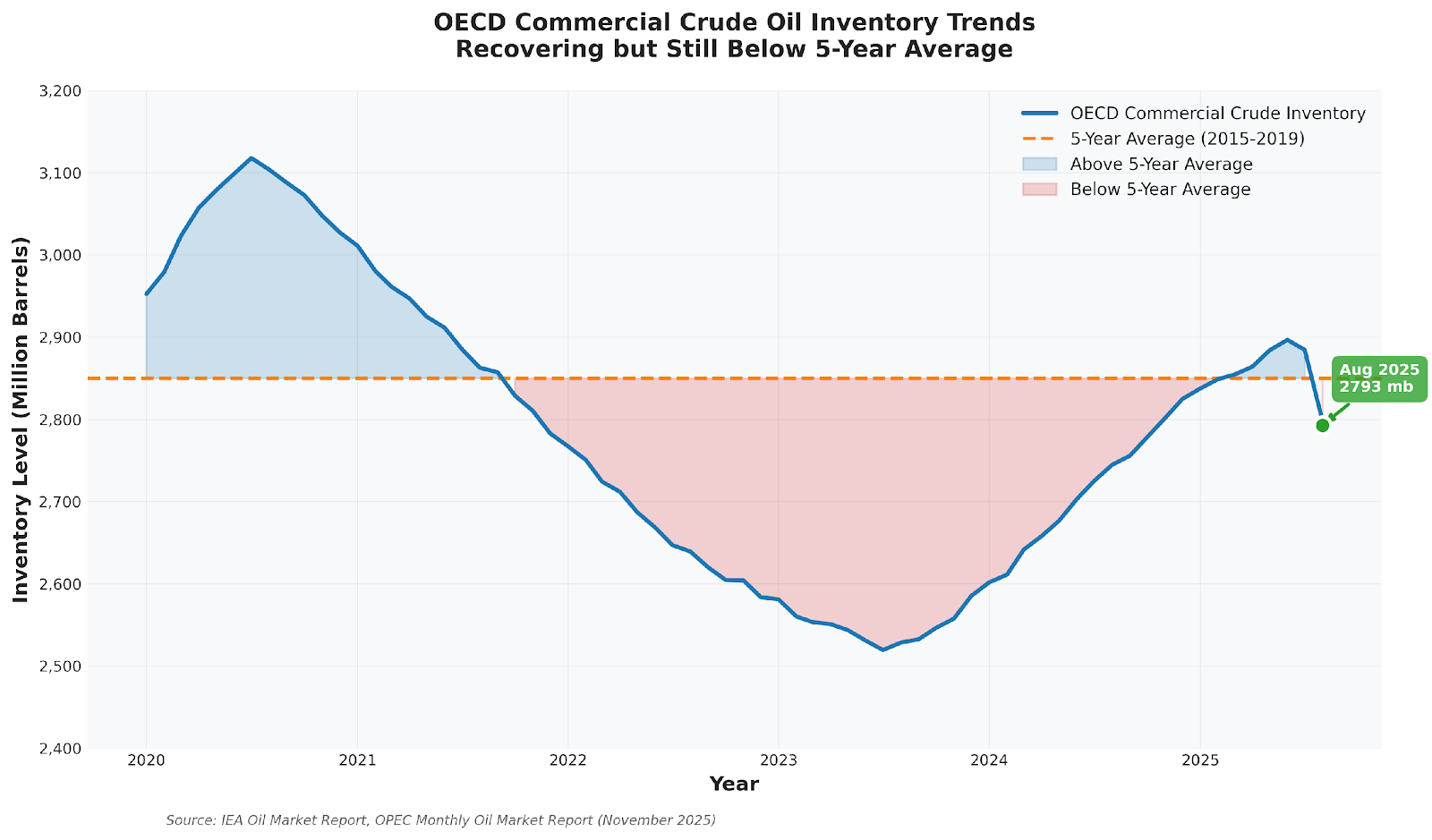
图 1:OECD 商业原油库存近 5 年对比最新水平,显示库存虽有回升但仍低于五年均值。
三、原油价格走势:WTI 与 Brent 如何消化预期
2023 年下半年,布伦特因供应紧张和地缘冲突预期一度突破每桶 90 美元。然而进入 2024–2025 年,随着供应回升和库存恢复,油价整体震荡下移。近期价格承压主要来自供应过剩预期强化以及美国库存意外上升。
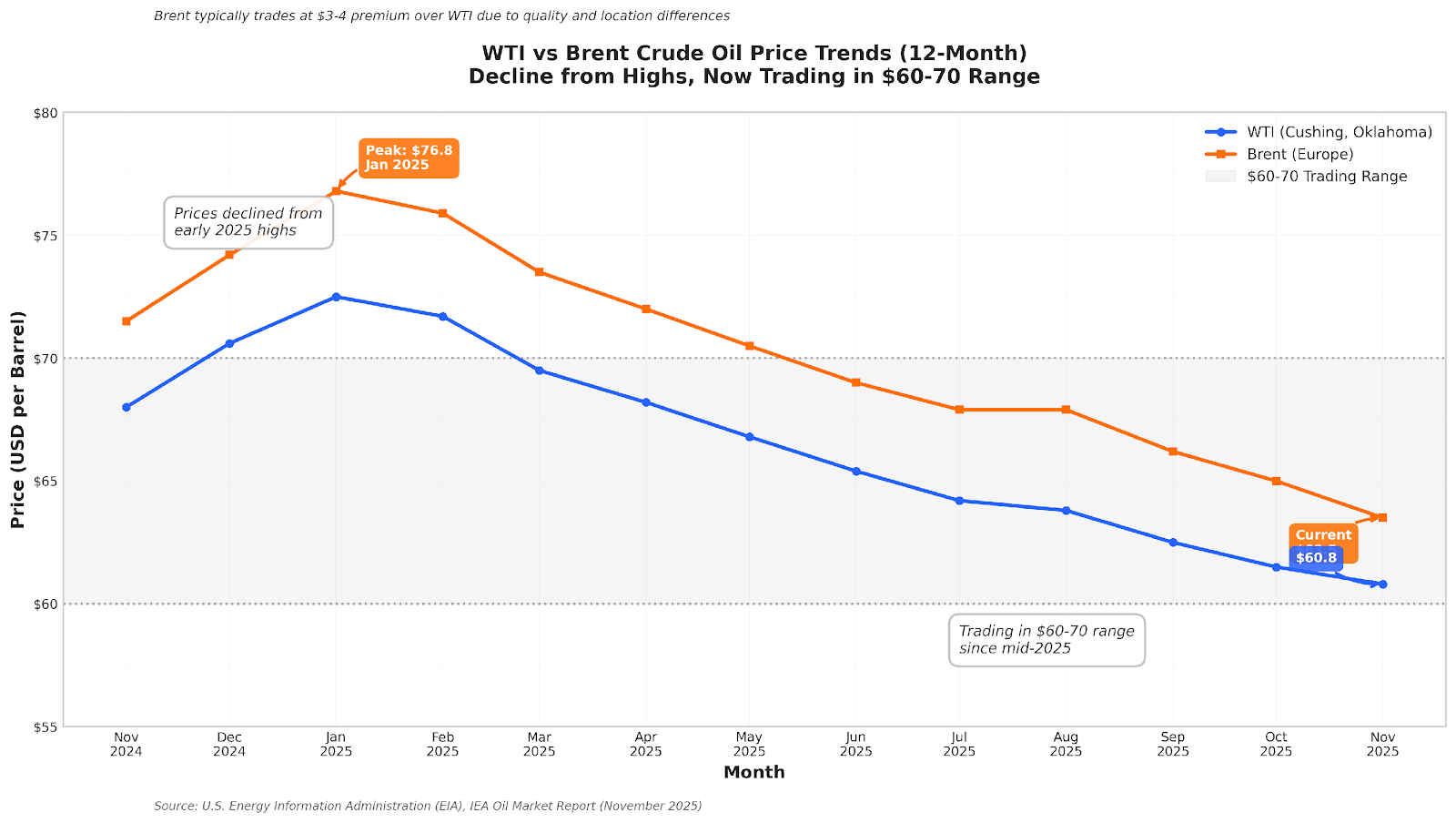
图 2:WTI 与 Brent 价格从 2025 年初的高位回落,近期在 60–70 美元区间震荡。
尽管地缘事件偶尔推升价格,但反弹难以持续,因为供应宽松的结构性预期迅速重新主导市场。WTI 与 Brent 的期限结构一度出现小幅 Contango,显示短期供应充裕压制近端价格,而远月因长期需求预期而保持相对坚挺。整体来看,油市呈现低波动、弱趋势但对消息高度敏感的特征。
四、驱动油市的关键变量:地缘政治与供应端不确定性
运输通道风险仍是油市最大的潜在冲击点之一。全球三分之一海运原油经过霍尔木兹海峡,一旦受阻便可能引发油价剧烈波动。衍生品定价显示断供概率虽低,但属于典型的“低概率、高冲击”事件。
OPEC+ 的政策滞后性也带来结构性波动。减产会压低库存、推高价格,但高油价又刺激非 OPEC 增产,使市场重新宽松。美国页岩油增速放缓进一步加剧供应端的不确定性,削弱其作为“摇摆产能”的角色。此外,俄罗斯、伊朗等国因制裁和冲突导致出口波动,更加剧油市敏感性。
五、油市变化的外溢影响
能源板块通常与油价同方向变动,但反应速度较油价更平缓。油价对风险偏好的溢出效应也容易影响澳元等商品货币。大宗商品价格上行往往提升商品出口国的贸易条件与风险情绪,而价格下跌则可能压制相关货币表现。
六、原油市场风险提示
- 数据发布风险: EIA 每周库存、IEA 与 OPEC 月报可能导致短线波动。
- 地缘政治风险: 产油区冲突、海运通道中断、制裁变化均可能影响供需平衡。
- 宏观风险: 利率政策、美元走势及全球经济增速变化都可能改变需求前景。
结语
IEA 最新展望显示,全球油市进入“边际紧平衡”阶段:库存修复但仍偏低,供应端不确定性大于需求端。在这种结构性环境下,油市会对政策、地缘事件与供给变化表现出高度敏感。理解供需框架、关注库存趋势与识别关键风险,将是未来判断油市走向的关键。
参考资料
[1] IEA (International Energy Agency). (2025, October). Oil Market Report - October 2025. https://www.iea.org/reports/oil-market-report-october-2025
[2] OPEC (Organization of the Petroleum Exporting Countries). (2025, November). Monthly Oil Market Report. https://publications.opec.org/momr
[3] EIA (U.S. Energy Information Administration). (2025, November). Short-Term Energy Outlook. https://www.eia.gov/outlooks/steo/


Trading requires a commitment of time. For each of us the amount of time we must dedicate to trading activities is limited and justifiably so by other life activities (for of course, we want trading to contribute rather than take away from lifestyle). Despite the importance of checking in on how you are using your trading time, commonly traders do not manage their time for their trading.
If you view your trading as like any other enterprise you are involved in, some would consider this vital part of your “Trading Business” in not only optimising effectiveness, but also in maintaining an appropriate life/trading balance. When doing this there are potentially three key questions you need answered: 1. What am I spending time on now with trading related activities? 2.
How much time should I spend with specific trading activities? 3. What do I do with this time to ensure it is effective and efficient? The first stage in this assessment is to audit this so you can plan to adjust what you are doing and the time you are spending on it to achieve the aim of improving your trading time management.
To this end we have attached such an audit tool to this article to help you get started (click on the download link below). We trust it may be useful in your efforts to treat your trading as you would a business. Download: time-management-tool Mike Smith Educator GO Markets Disclaimer The article from GO Markets analysts is based on their independent analysis.
Views expressed are of their own and of a ‘general’ nature. Advice (if any) are not based on the reader’s personal objectives, financial situation or needs. Readers should, therefore, consider how appropriate the advice (if any) is to their objectives, financial situation and needs, before acting on the advice.


The relative ease of online trading today has not only increased the opportunity of access but flexibility to trade different time frames that can better “fit” around other things going on in life. Trading short timeframes is a popular choice for many online trading strategies. Indeed, the shorter time-frame charts e.g. 15 minutes or less, are often peddled by so called trading gurus as the optimum way to trade index/commodity CFDs and Forex online.
However, in reality many short timeframe traders fail to achieve desired outcomes with many suggesting that those trading longer timeframes may do better. Obviously, whatever trading time-frame you choose is the right one for you (often dictated by lifestyle) but it does raise the question as to whether it is the timeframe itself or are there issues associated with short term trading that are the challenge. In this article we suggest three of the apparently common potential challenges (or “pitfalls” as we have chosen to call them) to facilitate awareness, if indeed trading shorter term charts is your online trading choice. 1 - Choice of time to trade Commonly, many shorter time-frame traders plan to ring-fence screen time, for example an hour per day, to execute their trading actions.
We know that there are times when markets are more likely to move (consistent with the release of economic data, and opening of the larger exchanges. Hence, if you are to ringfence time, logically this ideally should be consistent with such periods where changes are market sentiment are more acute. So, challenge one is ensuring that you choose the right times for your “ring-fencing” whenever you choose to switch on your PC and delve into the online trading world.
If we do not strive to make this happen, the lack of more obvious trading opportunities can often create an emotional response of desperation and urgency to find a trade that may work. Often resulting in trying to ‘force a trade’, or ‘talking yourself into a trade’ where perhaps no opportunity exists technically, these will rarely result in a positive outcome. 2 - The ‘thrill of the chase’ Trading short timeframes is often seen as being exciting. The idea of challenging the market “big boys” may appeal to some, but from a motivational point of view, it is questionable if this is the right mindset to come in with into the online trading arena.
Such excitement can be a highly charged emotional state, and although we have written before about the place for channelled and controlled emotions in trading, equally when things are not going well with a trade, decisions are likely to be made from this high emotional state, in this case becoming potentially destructive. Listen to your internal ‘language’ both when trades go for and against you, and make a judgement call as to whether this may be creeping up on you as a potential issue. After all, you are trading to make profit not to be “excited”, and logically ‘in the cold light of day’ know that a heightened emotional state is not the place to make consistently good trading decisions. 3 - “Sucked” into price movements Watching that profit/loss column go up and down can be almost hypnotic in nature, It is easy to get sucked in to watching price movements continuously.
With money being for many an emotive topic, seeing movements up and down again may evoke emotional decision making. This “sucked in by price” scenario can take over from following your trading system and CHART price action, which is the place from which decisions should be made. If this resonates the solution is simple.
Right click in the “toolbox” (or terminal on MT4) area and remove ‘profit’ from the columns that you can see. - So there is our top three for any of you endeavouring to improve outcomes from your online Forex trading, and online CFD trading, and what may be causative factors if shorter timeframes are failing to deliver the results that you had hope for. With such awareness, if any of these resonate with you, you have: The start point to begin to take actions to address any of these. Perhaps justification for looking at alternatives.
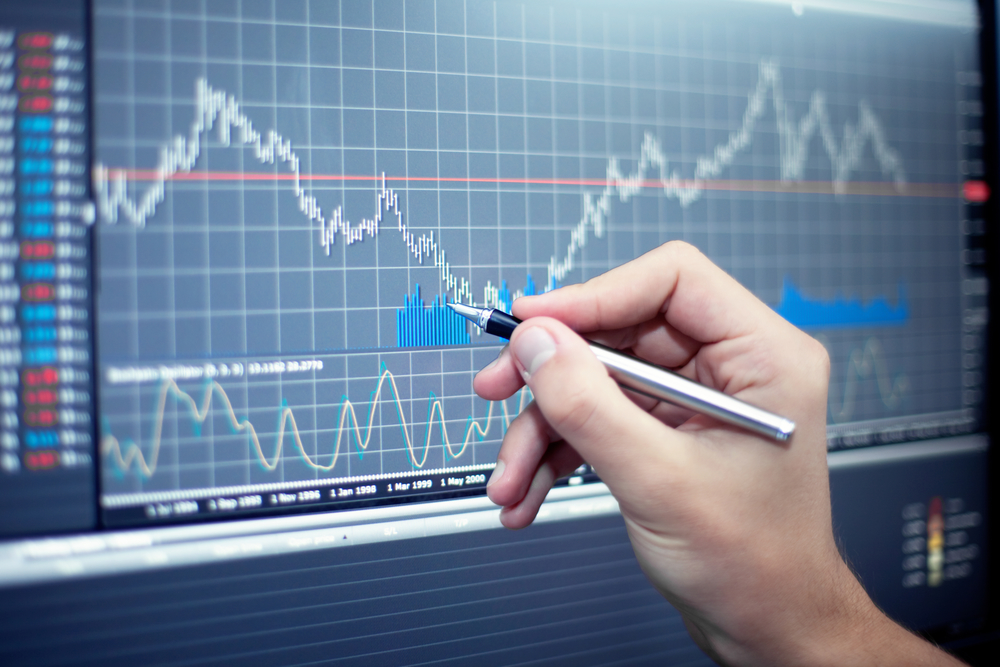

Invariably, the motivation to look at adding another technical indicator beyond that which you are already using, is a belief that your trading results, and the system that creates these, could be improved. As traders, we are bombarded with information relating to the use of technical indicators to guide decision making in our entry and exit decisions. Such information can be “persuasive” in making a change but as you are responsible for your trading decisions and subsequent results, it seems logical to start the process by asking the question “is it the right time for me to explore the use of another indicator?”.
The aim of this article is to highlight the FOUR critical questions you should ask of yourself first. 1. Am I REALLY trading my existing system NOW? As previously referenced, the major impetus for considering adding an indicator is to improve results when trading an existing system.
You can only make the judgement of any improvement if you both have a comprehensive system that specifies entry/exit/position sizing as a minimum AND are actually trading this. Potential trading actions The reality for most traders is that they fall down on one or both of these two CRUCIAL factors. Honesty with what you are doing now backed up with the evidence of journaling will give you the answer to this.
If these resonate with you, logically addressing these should be your priority. Without this, you are not able to make that judgement and hence adding another indicator is far less likely to impact positively on results. 2. Is adding another indicator the ONE major thing that is going to make the most difference to my trading results NOW or is there something else I should invest my energy on?
We have already specified two potential priorities in the previous point with reference to your trading plan and adherence to it. Also, we referenced the issue of evidence through journaling. As this is not only crucial for the above point, it is a vital part of your review process should you choose to investigate the use of a new indicator.
So again, could be viewed as a priority. Finally, addressing your knowledge relating to trading may be more important for you now. Not only are we referring to general trading learning but an in-depth understanding of what indicators including the ones you are using now, do and do not tell you about market sentiment.
This learning is again important in your judgement as to which NEW indicator could be useful. Therefore, again we would suggest this could be a priority over adding another indicator right now for you. Potential trading actions Prioritise your trading plan, discipline, journaling and learning, making sure these are at an appropriate level for you to invest time in exploring new indicators. 3.
Have I got absolute clarity about what another indicator should do to enhance my existing system? Previous points relating to journaling and learning should give you the ability to more ably identify what it is that a new indicator could add to your trading. The first decision in this process is to identify whether your focus is on improving entry or exit.
Once you have clarified this and If you have ticked other boxes so far, the other potential area for exploration is to look at the perimeters of the indicators/systems you are currently using as it may be that this could simply be the answer to create potentially better outcomes. For example, let’s assume you are using a price/10 EMA cross as an exit signal. You have found that one of the areas you wish to improve has not been taken out early on a regular basis by “market noise”.
It may be a simple case of testing a change e.g. to a price 20EMA cross that may make the difference you are seeking. Potential trading actions • Learn about the indicator you are using and make sure it is a fit for any gap you have identified in your existing system. • Don’t forget it may serve your purpose to look at a simple adjustment of perimeters of existing indicators you are using. This STILL needs testing before implementation. 4.
Have I got a formal process for testing an additional indicator in place that will produce the evidence to decide whether to include it within your trading plan? Ok so you have got this far, and so are ready to look at your new indicator. So briefly here are three process components you need to have in place. i.
Perform a back-test on previous trades to determine any change in dollar outcome across a critical mass of trades, Remember the purpose of any back-test is to justify the need for a forward or prospective test, NOT to change your system at this point. ii. Perform a prospective test (again deciding what critical mass of trades are enough on which to make a judgement) on a demo account using the indicator as you intend to do so in live trading. This may not only reinforce information from your back-test but adds the reality of new data coming into the market live and the tests the trades you may not have taken (if your previous entry indicators would have blocked action).
It is important that you keep ALL other trading plan perimeters the same to be able to confirm that it is your new indicator that is making any difference observed. iii. If your test produces a positive outcome, then articulate within your trading plan how you are going to use your new indicator. It is important that you ensure any statements are sufficiently specific (see an article on this HERE ) to guide action and measurement, and this should include under what market circumstances you would use it. iv.
Set a review date (e.g. 3 months) to determine how beneficial its continued use has been. Potential trading actions Ensure your process is not only clear but one you adhere to. You may use the above as a start point to developing you on process but remember to specify how many trades YOU think is a critical mass on which to make decisions.
We trust this has been useful and as always please feel free to ask questions of our team or email to [email protected] with your comments.
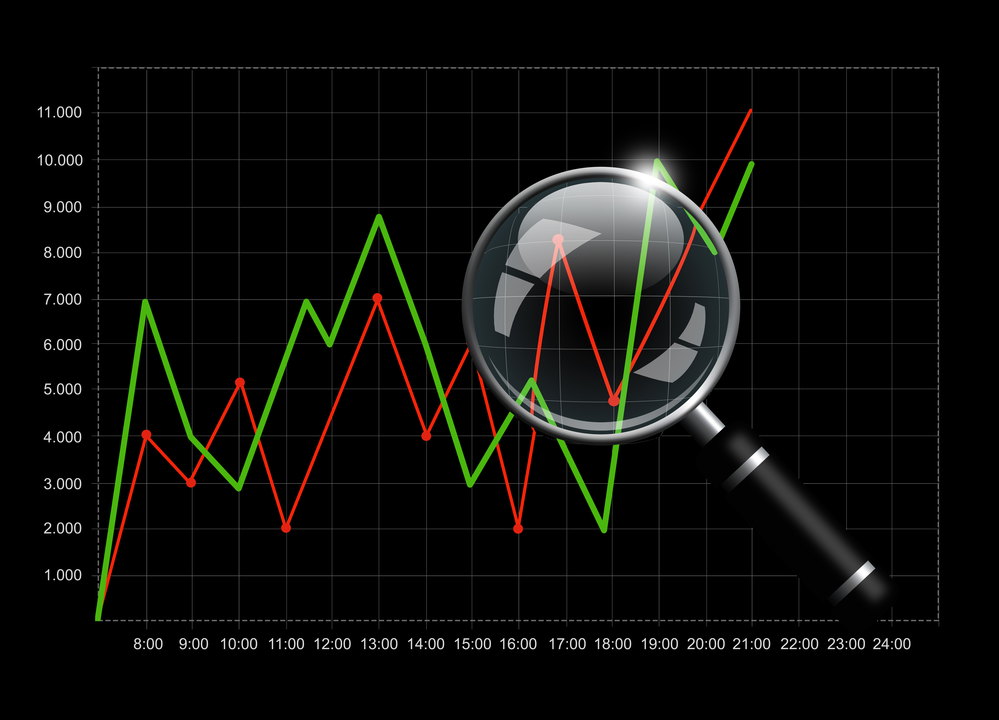

Position accumulation is to increase exposure to a currency pair, by adding a second (or more) position in the same trading direction. Although on the surface the opportunity to increase potential return is attractive, there are also risks that MUST be at the forefront of your thinking. These principles described in this article are appropriate for Share, Index and Commodity CFDs as well as obviously Forex positions.
Are you ready to accumulate? Before considering position accumulation to your trading behaviour, it is worth considering two important aspects: This is not a strategy for the beginner trader, but rather when other systems are already in place such as a written trading plan that includes statements that reference risk management approaches, particularly that of appropriate position sizing and clear exit approaches. Also, logically, as you are potentially increasing exposure with this approach, it is not only having a trading plan that is important, but also a record of follow through with that plan.
We know disciplined trading is a challenge for some, so if this is something you are battling with then master this first. Why a profitable position only? It is crucial that this is one of the rules of any system you choose to develop.
Accumulating into a losing position (akin to ‘dollar cost averaging)’ should be considered a very high-risk strategy. The essence of this approach is that at each accumulation point, as you increase exposure, you manage the additional risk by moving a stop on previous positions at each accumulation point. Your position accumulation system checklist As with any aspect of trading behaviour, a measurable set of statements that dictate your actions as part of your trading plan should be developed with reference to your position accumulation.
These statements should be specific, unambiguous and measurable to facilitate consistency in action and allow you to make judgements as to whether any refinements could be made subsequent to a review of a critical mass of such trades. These may include as a minimum: Under what market circumstances you would consider accumulating e,g. strong uptrend confirmed across multiple timeframes. What technical signals are you going to use to signal the time to accumulate (e.g. if into a long position, break of a key price point, subsequent to confirmation of continued uptrend after a retracement or the next technical resistance).
Your trail-stop process e.g. at each accumulation point for all previously opened positions -all opened positions should be treated as one re. your revised exit points as a trade goes in our direction. Position sizing e.g. accumulate no more than the original position, meaning if you enter 5 mini-lots initially that is the maximum you can add on each accumulation. Remember as you are trailing the initial stop of all accumulated positions you are risk managing through this method.
Your maximum exposure i.e. your total standard lots/contracts you are prepared to enter, e.g. if you accumulate 1 index CFD contract on each occasion how many times are you prepared to do this. Remember, as different instruments are positioned differently in terms of exposure you will have to specify this for each. It would be a nonsense to enter 1 Share CFD contract but may be appropriate to enter 1 gold CFD contract.
Other exit points or reason to delay/refrain from accumulating further e.g. economic data due. Once your system is complete then it should be tested prospectively, and amended as appropriate, prior to implanting in the reality of your trading practice. We trust this review of position accumulating will help in your choice as to whether to integrate this into your trading and of course, some of the considerations that are worth exploring and articulating within your plan.


By Mike Smith Let’s face it, trading can be a lonely occupation sometimes. Along with the hope of picking up a “hot tip”, this seems to be a key reason why trading forums are so popular. Unfortunately many people leave such forums almost as quick as they join them, simply because many users are not particularly supportive and often seem to be fuelled by ego-driven posting.
So, understanding that there are benefits from connecting with other traders, another option we’ve seen in action is to take on a trading buddy. This might be someone you know who has shown an interest in your battle against the markets, and they need not be the same level of experience as yourself. Indeed, it may be that they are only just beginning.
But that shared experience can create a difference. We’ve possibly identified THREE significant positives, and how trading buddies can not only increase your level of enjoyment when trading, but also reduce that “alone” feeling, and even potentially impact positively on results. Consider: 1.
Increased Accountability The very fact you have someone close that you can share your experiences with gives a layer of accountability that you will never get when you are trading without someone else knowing what you are doing. It’s easy to stray from whatever your trading “straight and narrow” is when no one is there to know. Logically, if you are sharing your experience of trades, those that go with you and those that don’t, there is one more reason to trade more consistently with your plan.
Beyond direct trading, there’s also the follow through in learning and system development that can be positively impacted upon by having someone else around. Recognising the potential benefits of this layer of accountability is why many traders seek out a coach and invest thousands of dollars in such. 2. Shared learning and experiences The benefit is based on the idea that “Two heads are better than one”.
Whether it be a theoretical trading concept, understanding and testing a trading indicator that you are considering using, or simply having someone on hand to encourage and support you, or even celebrate when things go well, a trading buddy can positively impact all of these. 3. More efficient and effective trading system development One of the critical tasks you face as a trader is to develop the systems that support your trading decision making. A staggering number of traders have no or incomplete trading plans, and no other systems in place that many believe are necessary.
Additionally, there’s the obvious benefit of measuring the success or otherwise of such systems and having a critical mass of trades as evidence that system changes may be useful. Developing and testing systems together and getting evidence more quickly with two people working on getting that critical mass of trades are definite positives for having a trading buddy. Making your trading buddy happen a.
Get one There are more advantages to having someone local (although much can be done online) who you can physically meet. This can not only be more enjoyable but more productive. Ideally, someone you already know and whose opinions you generally trust would seem logical.
Experience is less important than the above as we can help (see below) in bringing someone up to speed. Watch also for LIVE events happening across Australia we are running this year. One of the key objectives of these is to facilitate networking with other trades.
Also, check out Inner Circle if you are not already a member. Perhaps put the word out you are interested in having a trading buddy and see if anyone is interested. b. Get them trained If your prospective buddy is someone who has simply expressed interest in trading but not yet taken the plunge, point them in the direction of “First Steps”, our free education course.
It is designed for new traders and enables fast track learning. Get them up and running with a demo platform and of course ultimately a live trading account. If this is of interest, then connect with us ASAP and visit the FREE education page on the website.
If they already trade, get them involved in “Next Steps” and “Inner Circle” as appropriate, and direct them to the page on the website. c. Set some ground rules Any relationship needs them! It doesn’t have to be a formal session, just a simple ‘how can we both make this work’ conversation.
Documenting what you’re doing and writing plans for action can always help get the most out of it for both of you. We see some great potential advantages for you and your buddy and, of course, will facilitate that relationship through education and support as much as we can. Your next step is to consider whether the advantages we have discussed would be right for you and of course if they are, take action.
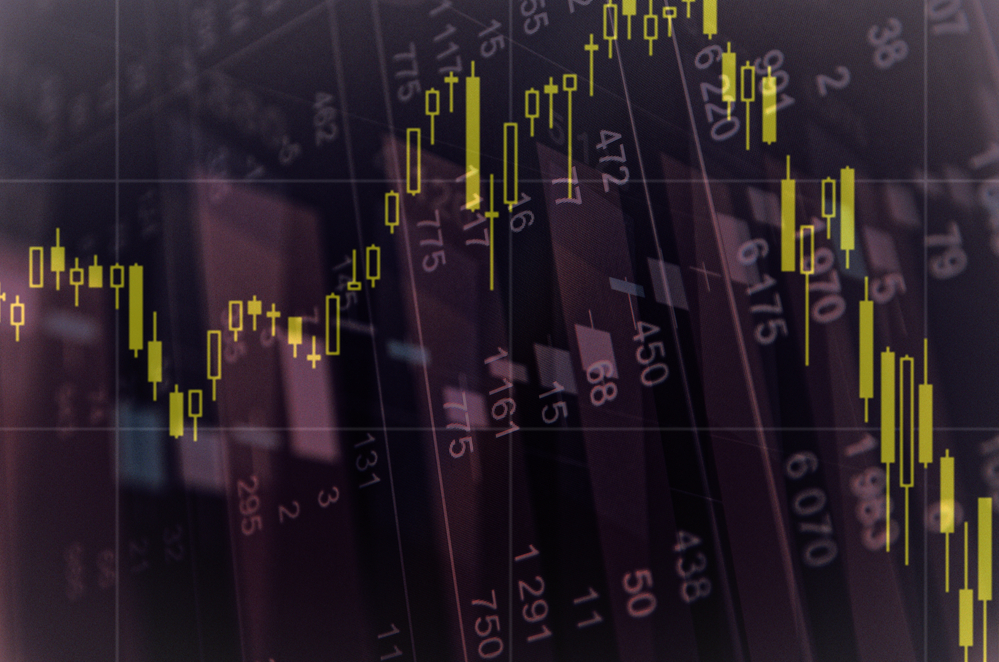

Volatility Revisited Volatility is a measure of the range of price movement over a defined period on a specific timeframe on which any calculation is performed. It may increase or decrease dependent on market conditions and aims to provide the trader with an indication as to whether the range price movement in subsequent candles/bar is likely to be large or small. Of course, as with the majority of indicators it is a lagging measure, in that it is calculated on previous candles and therefore this should be recognised by the individual trader when considering incorporating it into their own decision-making processes relating to entry and exit.
One of the most used volatility indicators is the Average True Range (ATR), and we have discussed this previously both in past articles and Inner Circle webinars sessions. As the basis of its calculation, it uses (as a default setting) the last 14 bars of price ranges and plots an average of this on a chart. Common uses include (along with other potential criteria): Setting of risk management stop Potential ‘trail stop’ and ‘profit taking’ strategies Use in “breakout” entry strategies Current Market Volatility A combination of concerns re. the continuing spread of Coronavirus and Oil pricing wars over the last fortnight, have created prolonged volatility levels not seen since the Global Financial Crisis (GFC) in 2008.
Although the root causes are dramatically different, price ranges have definite similarities. Such volatility can be seen across all time-frames and across all financial instruments, as market sentiment is flung one way and then the other, as continuing updates hit the newswires. To give context here are a few examples (using the ATR) comparing 10th March with the previous month: Potential Considerations for your Trading One of the first lessons that it is important to recognise as traders is that, we are trading “risk”.
It is price changes that create opportunity to profit and loss account capital. Appropriate management of this is CRITICAL in all trading situations, irrespective of market volatility. There is no doubt however that higher (and increasing) volatility means that the likelihood of a significant price move away from the current price of any instrument is increased in a shorter period of time than would be considered in the market norm (as illustrated by the figure in the table above).
As an individual investor, as part of your chosen risk management, there are some potential considerations that this heightened volatility that may be worth examining. ( Note: We are not aiming to be predictive rather, offer suggestion as to questions you could ask of your current trading actions). Should I be trading at all in current market conditions? As current market movements are fundamentally headline-driven and there is far less predictability than for example general economic data releases about the timing of such headlines hitting the newswires, does this merit reviewing the time-frames you would normally consider?
If you are not currently using a volatility indicator (such as an ATR) as part of your decision making, is it worth reviewing your criteria for entry/exit to incorporate this? Remembering that volatility is NOT considered to be a predictor of price direction to the entry or exit criteria you use. Do I reduce the tolerable risk limit I apply to any trade i.e. review the % of account capital you are prepared to risk on any trade (e.g. reduce from 2% to 1%)?
If you are using ATR for decision making re. breakouts, should you consider a review of how you are using this e.g. if you normally use a price close to 0.5 ATR above a resistance as part of your reason for entry into a long trade, would 1xATR above reduce the chances of “false breakouts”? There are three things we want you to take away from this article: The recognition that extraordinary market circumstances may merit a review as to how you may normally trade (including potentially giving yourself permission to step back from trading) and be in no doubt that these circumstances ARE extraordinary. As always, the trading choices you make mean that YOU are responsible for your trading results not the market irrespective of underlying market conditions.
Make copious journal records of what is happening and what you are doing. There will be times in the future when similar market conditions occur. As the majority of you, we are guessing and keen to view your trading as something you can do for a lifetime, treat this as an invaluable learning opportunity for what may work (or otherwise) for you next time it happens.

